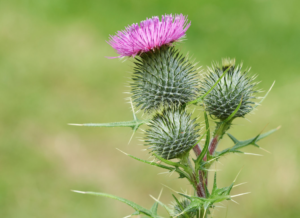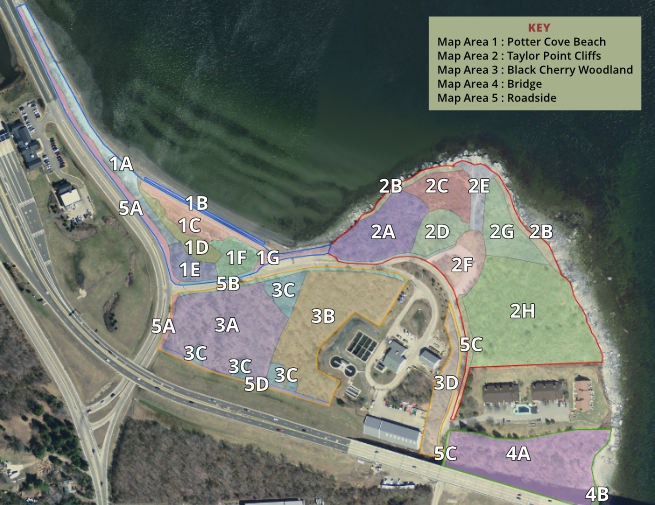Common Name: Bull Thistle
Specific Name: Ciasium vulgare
Known Occurrence at Taylor Point:
Map Areas: Beach 1E, Bridge 4A
Category: Non-Native, Herbaceous Plant

Ecological Considerations:
Ciasium vulgare is a tall biennial or short-lived monocarpic thistle that forms a rosette of leaves and a taproot up to two feet long in the first year, and a flowering stem, three to five feet tall in the second year. The stem is winged, with numerous longitudinal spine-tipped wings along its full length. The leaves are stoutly spined, grey-green, deeply lobed; the basal leaves grow six to ten inches long, with smaller leaves on the upper part of the flower stem. The leaf lobes are spear-shaped. The inflorescence is one to two inches in diameter, and is pink-purple. The seeds are about a tenth of an inch long, with a downy Pappus, which assists in wind dispersal and the pappus hairs are feathery with fine side hairs. Bull thistle grows well along roadsides, in pastures, and in disturbed areas.
The flowers are a rich nectar source for numerous pollinating insects, including honey bees, and butterflies. Monarch Butterflies feed from the flowers. Birds such as goldfinches eat the seeds of the Bull Thistle and also use down from seed pods to build their nests.
Problems Posed by this Plant:
Native Species Affected by this Plant:
Factors Affording a Competitive Advantage to this Plant:
Propagation Mechanisms and Related Issues Affecting Efforts to Remove and/or Eliminate this Plant from Taylor Point:
Bull thistle reproduces and spreads entirely from seeds. Its flowers are bisexual. While there is some evidence of self-pollination, selfing may result only in hollow seeds; therefore, bull thistle may require cross-pollination to set fertile seed. Only those plants that flower during the main flowering period, or where plants are growing in sufficient density, will contribute substantially to the following generation.
The seeds are dispersed by wind, mud, water, and possibly also by ants. They do not show significant long-term dormancy, most germinating soon after dispersal and only a few lasting up to four years in the soil seed bank.
Documented Best Removal Practices and Options/Pros and Cons of Various Options:
Digging the plant out with a spade is the best approach to mechanical bull thistle control. Take care to remove the entire fleshy taproot for best results. In order to reduce the seed population, cut off the seed head and tuck it into a sack to keep the fluffy seeds from dispersing.
Additional Photos:


Sources cited:
Brandeis Field Bio
U.S. Forest Service
Wiki Bull Thistle
Gardening Know How
Key Words:
Bull Thistle
Ciasium vulgare
Beach 1E
Bridge 4A
